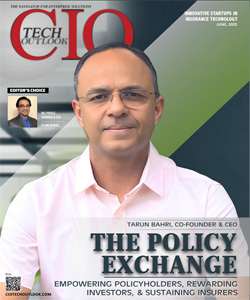How GRC Systems Serve as Guardrails for Responsible AI Adoption
Gaurav Kapoor, Co-Founder and Vice Chairman, MetricStream
 Gaurav Kapoor, Co-Founder & VP Chairman, MetricStream is responsible for AI-first growth, customer expansion and market strategy. Prior to being CEO, he has served in various leadership positions such as Co-CEO, COO and CMO and as the organization’s founding CFO, leading MetricStream to its position as the global leader in Governance, Risk and Compliance (GRC).
Gaurav Kapoor, Co-Founder & VP Chairman, MetricStream is responsible for AI-first growth, customer expansion and market strategy. Prior to being CEO, he has served in various leadership positions such as Co-CEO, COO and CMO and as the organization’s founding CFO, leading MetricStream to its position as the global leader in Governance, Risk and Compliance (GRC).
The world is at the edge of a technological revolution, and countries like India are at the forefront of this transformation. As more businesses globally integrate artificial intelligence (AI) into their daily operations, the need for strong governance, risk, and compliance (GRC) practices has never been more critical.
What is also important is that despite the opportunity-rich environment, the need of the hour is for organizations to ensure that innovation doesn’t come at the cost of ethics, security, or trust.This is where solid GRC frameworks play a key role, not just as a safety net but as essential guardrails so that AI adoption can be steered responsibly.
AI Adoption and Its Rapid Climb
Globally, the adoption of AI in business processes is at an all-time high in 2025. As per a PwC survey, nearly half (49%) of tech leaders said AI is now entirely woven into their company’s core business strategy. About a third said it’s also fully integrated into their products and services.
Likewise, India’s business landscape is also witnessing a surge in AI implementation. According to an Associated Chambers of Commerce and Industry of India (ASSOCHAM) report, 23% of Indian businesses have already implemented AI solutions, surpassing other surveyed markets. Even more impressively, 73% of Indian companies expect to expand their AI use in 2025, far above the global survey average of 52%.
This surge isn’t surprising. With a young workforce, booming digital economy and a government actively pushing initiatives like the National AI Mission, India is poised to become a global AI hub. But with rapid adoption comes significant responsibility.
The Double-Edged Sword of Generative AI
One of the most exciting (and challenging) innovations in AI is generative AI. Tools like ChatGPT have captured the world’s imagination, boasting over 180 million users by early 2024. Generative AI can automate tasks, assist employees in real time, and even create original content with minimal human input.
Studies show that up to 80% of an employee’s tasks could be automated using AI, which presents enormous efficiency gains. However, this power comes with its own set of risks. Generative AI systems can unintentionally spread misinformation, expose sensitive data, or produce biased outputs. If left unchecked, such flaws can lead to severe reputational, legal, and financial damage.
ADeloittesurvey found that only 25% of leaders feel their organizations are “highly” or “very highly” prepared to manage GRC issues related to AI adoption. Their biggest concerns include:
- Lack of confidence in AI results (36%)
- Intellectual property issues (35%)
- Misuse of customer data (34%)
- Regulatory compliance gaps (33%)
- Lack of transparency in AI decisions (31%)
The message is clear: companies cannot afford to overlook GRC when implementing AI.
The Evolving Role of Compliance Teams
Traditionally, compliance teams have been the custodians of regulatory adherence. Now, they also need to anticipate and manage the new threats AI brings.
Interestingly, AI can itself be a powerful tool for compliance departments. According to Deloitte, 62% of organizations reported that AI significantly improved the efficiency of their compliance procedures, primarily by automating audits, risk assessments, and monitoring activities.
However, compliance officers must now wear two hats;Using AI to make their functions more efficient and advising the organization on safe, responsible AI usage across all departments.
Their role is vitalin making sure AI is implemented wisely.
Why GRC Systems Are Non-Negotiable for AI
AI’s complexity demands that companies move beyond fundamental compliance checklists. A strong GRC framework provides structured ways to manage the unknowns AI introduces.
Here’s how organizations can embed GRC into their AI journey:
Define Clear Governance Roles
Organizations need to define roles and responsibilities for AI oversight clearly. It is necessary to appoint a senior leader, such as the Chief Data Officer or Head of R&D, with technical and business understanding to drive ethical AI initiatives. Policies should align with industry standards like the NIST AI Risk Management Framework and the ISO/IEC AI standards.
Conduct Detailed Risk Evaluations
AI systems should be evaluated regularly to identify and address potential risks, such as bias or discrimination, security vulnerabilities, model manipulation, and compliance gaps. In India, emerging guidelines like NITI Aayog’s Responsible AI for All strategy provide practical blueprints for managing these risks and promoting responsible AI adoption.
Promote Transparency
A black-box AI system (one where no one can explain how decisions are made) is a ticking time bomb. It’s best to have interpretable AI models. Businesses must also communicate how data is collected, stored, and used.
Implement Constant Monitoring
AI systems evolve with data. That means what works today might not work tomorrow. Organizations need real-time monitoring systems to detect when an AI’s behaviordrifts away from its intended outcomes.
Build a Cross-Disciplinary AI Ethics Committee
Organizations must bring compliance, IT, legal, HR, and business unit stakeholders to review AI projects. Diverse perspectives can identify ethical red flags early and promote balanced decision-making.
Train Employees on Ethical AI Practices
Frontline employees interacting with AI need to understand the ethical, legal, and operational risks. Regular training and awareness programs are crucial, particularly in an evolving market like India, where digital literacy varies widely.
Global Regulations Are a Warning Bell
Internationally, the regulatory momentum around AI is accelerating. Europe has introduced the EU AI Act, the world’s first comprehensive AI law.The US has framed the AI Bill of Rights. Countries like Singapore, Australia, and India have also issued responsible AI guidelines.
However, without a proper GRC system to check the use of AI in processes, companies constantly risk facing regulatory fines, data breaches, reputational damage, and, ultimately, a loss of customer trust.
AI will reshape industries, careers, and economies. However, the path to AI-driven success is filled with hidden pitfalls for businesses. This means solid GRC systems aren’t just “nice-to-haves.” They are the essential guardrails that will separate the organizations that thrive in the AI age from those that falter.
In a world moving at the speed of algorithms, ethics, governance, and risk management will keep human values at the centre of innovation.




